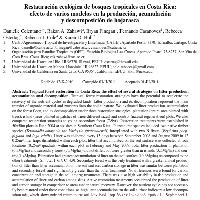Resumen
- Estrategias de restauración tienen el potencial de acelerar el restablecimiento del ciclo de nutrientes en áreas degradadas. En este estudio, se evaluó la producción de hojarasca, su acumulación y descomposición bajo tres tratamientos: plantación (toda la superficie plantada); islas (árboles sembrados en parches de tres tamaños) y testigo (regeneración natural). También se compararon bosques secundarios jóvenes (7-9 años). Los tratamientos fueron establecidos en parcelas de 50x50m en junio 2004 en seis sitios en el sur de Costa Rica. Las especies introducidas fueron dos maderables (Terminalia amazonia y Vochysia guatemalensis) intercaladas con dos fijadoras de nitrógeno (Erythrina poeppigiana e Inga edulis). La producción total de hojarasca en la plantación y bosque secundario no difirió significativamente, fue mayor que en las islas y el testigo. La plantación presentó mayor acumulación de hojarasca sobre el suelo. Los resultados indican una gran variabilidad entre los sitios. Ambas estrategias de restauración activas aceleraron la producción y acumulación de hojarasca en comparación con la regeneración. No obstante, eso no implica la restauración del ciclo de nutrientes. La elevada acumulación de hojarasca sobre el suelo indica baja tasa de descomposición y de retorno de nutrientes al suelo.
- Tropical forest restoration strategies have the potential to accelerate the recovery of the nutrient cycles in degraded lands. Litter production and its decomposition represent the main transfer of organic material and nutrients into the soil substrate. We evaluated litter production, accumulation on the forest floor, and its decomposition under three restoration strategies: plantation (entire area planted with trees), island (trees planted in patches of three different sizes) and control (natural regeneration) plots. We also compared restoration strategies to young secondary forest (7-9yr). Restoration treatments were established in 50x50m plots in June 2004 at six sites in Southern Costa Rica. Planted tree species included two native timber species (Terminalia amazonia and Vochysia guatemalensis) interplanted with two N fixers (Erythrina poeppigiana and Inga edulis). Litter was collected every 15 days between September 2008 and August 2009 in 12 0.25m2 litter traps distributed within each plot; litter that accumulated on the soil surface was collected at four locations (0.25m2 quadrats) within each plot in February and May 2009. Total litter production in plantation (6.3Mg/ha) and secondary forest (7.3Mg/ha) did not differ, but were greater than in islands (3.5Mg/ha) and control (1.4Mg/ha). Plantation had greatest accumulation of litter on the soil surface (10.6Mg/ha) as compared to the other treatments (SF=7.2; I=6.7; C=4.9). Secondary forest was the only treatment with a greater annual production of litter than litter accumulation on the soil surface. Carbon storage in litter was similar between plantation and secondary forest, and significantly greater than the other treatments. No differences were found for carbon concentration and storage in the soil among treatments. There was also high variability in the production and accumulation of litter and carbon among sites. Active restoration treatments accelerated the production of litter and carbon storage in comparison to areas under natural recovery. However, the nutrient cycle has not necessarily been restored under these conditions, as high litter accumulation on the soil surface indicates a low decomposition rate, which slows nutrient return to the soil.
